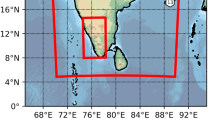Abstract
Rainfall amount drawn by typhoon events accounts for a significant portion of annual rainfall in Taiwan. Changes in typhoon rainfall due to climate change may have severe consequences for water resources management. A stochastic simulation approach is proposed for evaluation of changes in typhoon rainfall under certain climate change scenarios. The number of typhoon events and total rainfall of individual typhoon events are, respectively, considered as random variables of the Poisson and Gamma distributions. Climate change scenarios were set by varying various degrees of changes in average number of typhoon events annually and the mean of event-total rainfall. Using stochastic simulation, basin-wide annual typhoon rainfalls were simulated for the Shihmen Reservoir watershed in northern Taiwan. It is found that 10% increases in average annual number of typhoon events and mean event-total rainfall will result in 18% increase in the annual typhoon rainfall of 5-year return period, whereas the annual typhoon rainfall of 10-year return period will increase by 15% under the same climate change scenario. Such increases may cause significant increase in reservoir sediment and pose challenges to reservoir management.




Similar content being viewed by others
References
California Climate Change Center (2006) Scenarios of climate change in California: an overview. California Energy Commission, 47 pp
Chan JCL, Xu M (2008) Inter-annual and inter-decadal variations of landfalling tropical cyclones in East Asia. Part I: time series analysis. Int J Climatol. doi: 10.1002/joc.1782
Chu PS, Zhao X (2004) Bayesian change-point analysis of tropical cyclone activity: the Central North Pacific case. J Clim 17:4893–4901
Ghosh S, Mujumdar PP (2006) Future rainfall scenario over Orissa with GCM projections by statistical downscaling. Curr Sci 9(3):396–404
Gleick PH, Adams DB (2000) Water: the potential consequences of climate variability and change for the water resources of the United States. The Report of the Water Sector Assessment Team of the National Assessment of the Potential Consequences of Climate Variability and Change, 151 pp
Goh AZC, Chan JCL (2009) Interannual and interdecadal variations of tropical cyclone activity in the South China Sea. Int J Climatol. doi:10.1002/joc.1943
Guan B, Chan JCL (2006) Nonstationarity of the intraseasonal oscillations associated with the Western North Pacific Summer Monsoon. J Clim 19:622–629
Hanson RT, Dettinger MD (2005) Ground water/surface water responses to global climate simulations, Santa Clara-Calleguas Basin, Ventura, California. J Am Water Resour Assoc 41(3):517–536
Li X, Sailor D (2000) Application of tree-structured regression for regional precipitation prediction using general circulation model output. Clim Res 16:17–30
Salvadori G (2003) A generalized pareto intensity duration model of storm rainfall exploiting 2-copulas. J Geophys Res 108(D2):4067
Tsou CH, Lee CJ (2008) Interdecadal variability of the typhoon activity in autumn. Tropical Meteorology Special Symposium, New Orleans, LA, USA
Tu JY, Chou C, Chu PS (2009) The abrupt shift of typhoon activity in the vicinity of Taiwan and its association with western North Pacific-East Asian climate change. J Clim. doi:10.1175/2009JCLI2411.1
Wada A, Chan JCL (2008) Relationship between typhoon activity and upper ocean heat content. Geophys Res Lett 35:L17603. doi:10.1029/2008GL035129
Webster PJ, Holland GJ, Curry JA, Chang HR (2005) Changes in tropical cyclone number, duration and intensity in a warm environment. Science 309:1844–1846
Wu L, Wang B, Geng S (2005) Growing typhoon influence on East Asia. Geophys Res Lett 32:L18703. doi:10.1029/2005GL022937
Xu H, Corte-Real J, Qian B (2007) Developing daily precipitation scenarios for climate change impact studies in the Guadiana and the Tejo basin. Hydrol Earth Syst Sci 11(1):1161–1173
Yue S (2001) A bivariate gamma distribution for use in multivariate flood frequency analysis. Hydrol Process 15:1033–1045
Zhao X, Chu PS (2006) Bayesian multiple change-point analysis of hurricane activity in the Eastern North Pacific: a Markov chain Monte Carlo approach. J Clim 19:564–578
Acknowledgments
The authors are grateful for the financial support (96-2625-Z-002-008-MY2) of the National Science Council of Taiwan, ROC.
Author information
Authors and Affiliations
Corresponding author
Rights and permissions
About this article
Cite this article
Cheng, KS., Hou, JC., Wu, YC. et al. Assessing the impact of climate change on annual typhoon rainfall—a stochastic simulation approach. Paddy Water Environ 7, 333–340 (2009). https://doi.org/10.1007/s10333-009-0183-9
Received:
Accepted:
Published:
Issue Date:
DOI: https://doi.org/10.1007/s10333-009-0183-9




